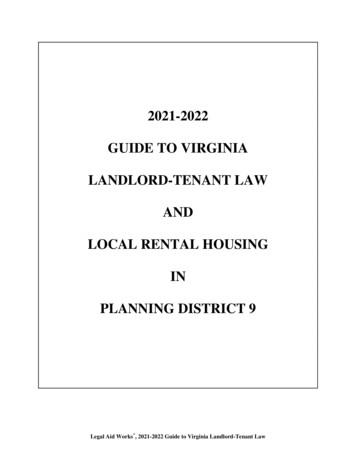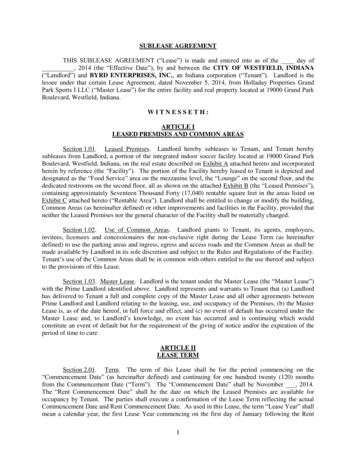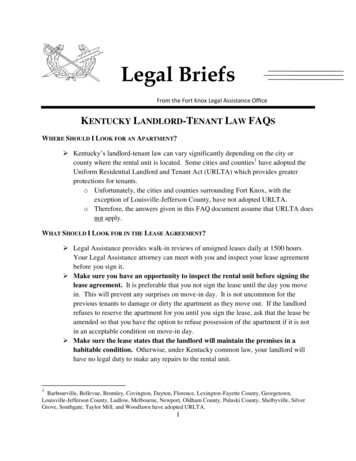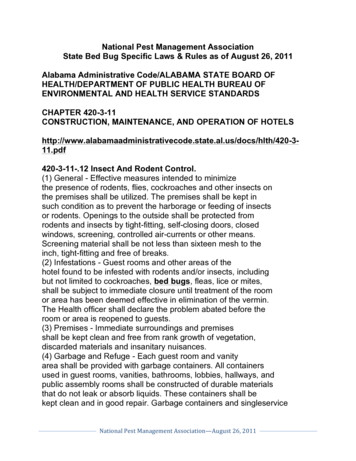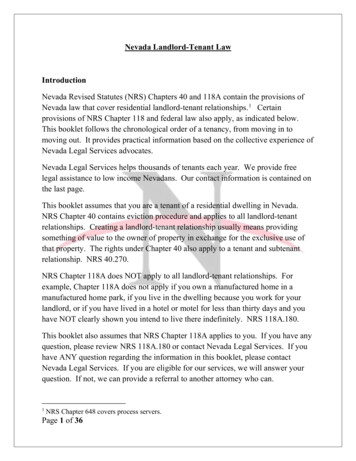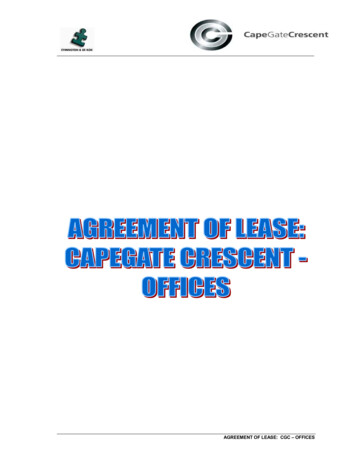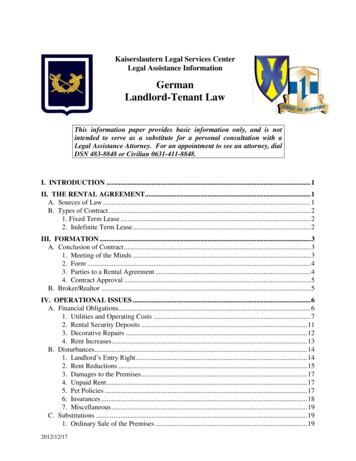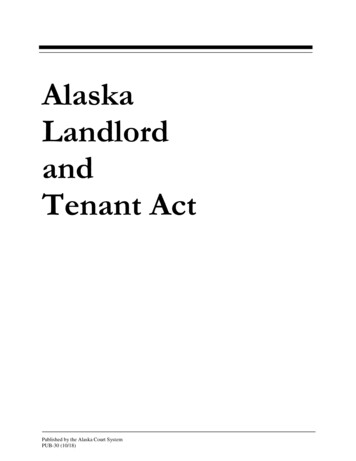
Transcription
AlaskaLandlordandTenant ActPublished by the Alaska Court SystemPUB-30 (10/18)
NOTICE:This publication includes a summary of landlord and tenant rights and obligations underAlaska law, provided by the Alaska Department of Law. Their publication was lastupdated in 2014. Go to lordtenant.html to update this printed information. In accordance with Alaska Statute (AS)44.23.020 (b)(9), information in their publication has been approved by the AlaskaDepartment of Law.The Alaska laws governing landlord and tenant rights and obligations reproduced hereare from the 2018 Alaska Statutes. Laws are subject to revision by the legislature. It isyour responsibility to check for any amendments to the Alaska Statutes by visiting theAlaska Legislature website at http://www.legis.state.ak.us/basis/folio.asp, contactingyour nearest Legislative Information Office, or going to your local public or law library.The Alaska Court System offers an electronic version of its Eviction booklet, CIV-720 onits website at v-720.pdf. CIV-720describes procedures for evictions from residential property. CIV-720 is also available atall Alaska Court System locations.The Alaska Court System encourages you to read and familiarize yourself with theAlaska Uniform Residential Landlord and Tenant Act (Alaska Statute 34.03.010 - AS34.03.380) before taking any action affecting your or another person’s rights.PUB-30 (10/18)1
Table of ContentsLandlord Tenant Act: What it means to you . 3What housing is covered by the Act? . 3Definitions . 3Moving InMoving OutGet a written agreement . 4The agreement should include . 4Late charges . 5Resolving disputes . 5Understanding the agreement . 5What to watch out for . 5Standard form agreements . 6Illegal provisions in the contract . 6Special rules for mobile home rentals . 6Unsigned or undelivered agreements . 6What is a lease? . 7What is a security deposit? . 7Where are deposits kept? . 7Can deposits earn interest? . 8When there’s a new owner . 8Get a written inspection report . 8Living by the landlord’s rules . 9Enforcing the rules . 9Changing the rules . 9If circumstances change . 9When is discrimination illegal? . 10Give plenty of notice! . 20How much notice is enough? . 20Notice is notice . 21How to deliver notice . 21Cleaning up & clearing out . 21Damages . 21Returning the deposit . 22When landlord keeps the deposit . 22Termination of tenancy . 23Termination for late rent . 23Termination for deliberate damage . 23Termination for illegal activity . 24Termination for failure to pay utility bills . 24Termination for breach of duties . 24Landlord’s termination by choice . 24Termination of mobile home tenancies . 25Termination for absence or abandonment . 25When is it abandonment? . 25Abandoned belongings . 26Holding a public sale . 26Serving a notice to quit . 27Foreclosure problems . 27Lockouts, utility shutoffs and threats . 28Subsidized housing . 28Retaliation by landlord . 28When it’s NOT retaliation . 29If the tenant won’t move . 29How F.E.D. cases work . 29When a problem arises . 30Follow these suggestions . 30Where to go for help . 31Living In a Rental PropertyThe landlord’s responsibilities . 11Property maintenance . 11Varying landlord duties . 12Tenant remedies . 13Housing codes . 14Tenant responsibilities . 14Landlord remedies . 16If the landlord needs to get in . 16The lowdown on locks . 17Can the landlord raise the rent? . 17Fire or casualty damage . 18Condemned dwellings . 18Moving prior to end of lease . 18Subleasing . 19Lawful reasons for denial . 19PUB-30 (10/18)Sample Notice Forms . 32-46Selected Relevant Statutes . 47-632
The Landlord and Tenant Act: what it means to youWhen a landlord and tenant get along well, things are better all around. Dealing with unhappy tenants is alot of trouble for a landlord, and few tenants want the inconvenience and expense of moving simplybecause they cannot get along with their landlords.Yet, landlords and tenants frequently have problems. Sometimes, landlords do not make repairs orunfairly keep back security deposits. Sometimes, tenants damage property or refuse to pay the rent.This booklet briefly explains your responsibilities as a landlord or a tenant under the Uniform ResidentialLandlord and Tenant Act (AS 34.03.010 et seq., the “Landlord and Tenant Act”). It explains what a tenantneeds to know when the tenant is: Moving in: . pages 4 - 11Living there: . pages 11 - 19Moving out: . pages 20 - 31Sample forms, such as notices to quit, etc., begin on page 32.The Landlord and Tenant Act covers rental of a residence, such as an apartment, a mobile home, or ahouse. It does not apply to rooming houses, hotels or motels, temporary housing at a shelter orsupportive housing program, or any type of commercial property.1Tenants who receive a government housing subsidy or live in a government housing project may haverights in addition to those provided by state law. This pamphlet does not cover those issues.Such tenants should check their lease agreements and may also wish to consult with the Alaska HousingFinance Corporation or an attorney for specific advice.DefinitionsSeveral important terms are used in this booklet. This is what some of them mean: Dwelling unit, property or premises: the place that is rented, which could be a house, apartment,condo, mobile home, or mobile home park space. Landlord: the property owner or the owner’s agent, which could include either a licensed propertymanager or a resident manager. Property manager: an individual licensed to practice real estate in Alaska who works on behalf ofthe property owner to rent, manage and safeguard a property. Resident manager: an individual who resides on the property and manages it on behalf of theproperty owner or the licensed property manager. Tenant: any of the people who rent the dwelling. Damages: money claimed by, or ordered to be paid to, a person as compensation for loss or injury. Itmay mean the amount claimed by the landlord from the tenant’s security deposit based on thedamages the landlord has incurred by reason of the tenant’s failure to comply with the obligationsimposed under the Landlord and Tenant Act. Or it may mean the monetary compensation that aperson wins in a lawsuit, such as the value of lost rent or the cost of repairing property damage (to alandlord), or the value of housing or utility services not provided (to a tenant). Security deposit: payment to a landlord or property manager by a tenant to ensure that the tenantwill pay the rent due and will maintain the property and will not damage it. Security deposits are heldin trust by the owner or manager until the tenant moves out, and are then returned or applied to payfor damages and/or delinquent rent with an accounting to the tenant. Rental agreement: means all agreements, written or oral, and valid rules and regulations adopted bythe landlord, making up the terms and conditions for the use of the dwelling unit. Lease: a contract which conveys the right to use and occupy property for a certain specified period oftime in exchange for consideration, usually rent. Precise legal definition of many of the terms used inthe Landlord and Tenant Act may be found at AS 34.03.360.1AS 34.03.330.PUB-30 (10/18)3
MOVING INGet a written agreement:Before a tenant moves in, the landlord and tenant must come to an agreement. It may be verbal orwritten, but written is best. Without written proof, even two honest people can later disagree on what wasactually said. The written agreement may be called a “Rental Agreement,” a “Tenant Agreement,” or a“Lease.”The agreement should include: the name and address of the person authorized to manage the premises; the name and address of an owner of the premises, or a person authorized to act as an agent of theowner, for the purpose of service of process and receiving notices and demands from the tenant orthe owner’s agent; the name and address of the tenant(s);2 how many tenants and pets are to occupy the unit; who holds the deposit; reasons the deposit or a portion of it may be retained by the landlord; the amount to be paid for rent and deposits; when, where, and how the rent is to be paid; when the rent is considered delinquent, and what the penalty will be for late payment; whether this is a month-to-month tenancy or a lease with a definite contract period; who pays for utilities and what services are provided; list of prohibited equipment (snowmobiles, musical equipment, motorcycles, etc.); list of landlord and tenant repair and maintenance duties and who pays for them; rules on subleasing or assignment of the property; a premises condition statement and contents inventory; disclosure of lead-based paint as applicable for units built prior to 1978 (as required by the federalEnvironmental Protection Act); and any additional rules, covenants and regulations in place.2AS 34.03.080(a).PUB-30 (10/18)4
Late chargesThe Landlord and Tenant Act does not state whether landlords may assess late charges when the rent islate, or NSF fees when a check is returned for insufficient funds. It may be all right for the rentalagreement to specify a small flat-rate late charge or NSF fee that reasonably approximates the landlord’sactual costs caused by the tenant’s failure to pay rent on time or writing a bad check. It may also be allright for the rental agreement to specify a reasonable percentage-per-day late charge. Such a charge islimited by the state usury law to an annual interest rate of a maximum of five percentage points above theFederal Reserve discount rate, or if no precise rate is specified, 10.5%. 3 Remember, no automatic latecharge or NSF fee is legally enforceable, unless it has been agreed upon beforehand.Resolving disputesA landlord and tenant can agree to mediation or binding arbitration to resolve disputes between them. Ifboth parties want to mediate or arbitrate disputes, they should include in the rental agreement (or in anaddendum to it) specific details of the types of disputes to be resolved in this way and the procedures tobe followed.4Understanding the agreementRental agreements are normally prepared by the landlord or the landlord’s agent. It is very important thattenants make sure they understand all the terms of the agreement. Tenants should ask for an explanationof any section they do not understand, before signing the agreement.What to watch out for:Rental agreements cannot: require the tenant or the landlord to waive any legal rights under the Act, 5 permit the landlord to get an “automatic” court judgment against the tenant (called a “confession ofjudgment”),6 require the tenant to agree to pay the landlord’s attorney fees,7 limit the liability of landlords or tenants when either has failed to meet their responsibilities,8 make the tenant liable for rent even if the landlord fails to maintain the premises as required by law, 9 or allow the landlord to take the tenant’s personal belongings.103AS 45.45.010.AS 34.03.345.5AS 34.03.040(a)(1)6AS 34.03.040(a)(2)7AS 34.03.040(a)(4)8AS 34.03.040(a)(3)9AS 34.03.050; AS 34.03.100(a).10AS 34.03.250.PUB-30 (10/18)45
Standard form agreementsSome standard form rental agreements have been written to conform to the laws of other states, or arebased on older versions of Alaska law. These forms may need to be changed before signing them. Inaddition to the legal provisions already listed, any of the following statements should be removed from theagreement before signing it: agreement to let the landlord come into the dwelling whenever the landlord wants, agreement to immediate eviction for nonpayment of rent, agreement that the tenant will make all repairs, release of the landlord from liability for accidents due to the landlord’s neglect, giving up of the tenant’s right to the return of the deposit, or grant of a power of attorney to the landlord by the tenant, or to the tenant by the landlord.Illegal provisions in the contractTo remove illegal wording, draw a line in ink through any provision that is not legally binding. Both thelandlord and tenant should initial the agreement next to each item that has been removed.Illegal provisions in an agreement are not enforceable against the tenant, even if both parties sign.Special rules for mobile home rentalsAbsent very specific exceptions, agreements between mobile home park operators and mobile home parktenants may not: prohibit the tenant from selling the tenant’s mobile home, require the mobile home tenant to provide permanent improvements to park property, require a fee to let the tenant sell or transfer the mobile home, or require a fee to let the tenant set up or move a mobile home into or out of the park. 11Mobile home park operators must give tenants a list of all capital improvements that will be required (suchas skirting, utility hook-ups, and tie downs) before the tenant moves into the park.12 Park operators mayspecify the type of equipment required, but cannot require that it be purchased from a particular supplieror company.13Unsigned or undelivered agreementsOnce the agreement has been carefully reviewed, both parties should sign it. The landlord must give thetenant a copy.If the landlord and the tenant agree to a rental agreement, and the landlord signs and delivers theagreement to the tenant but the tenant doesn’t sign it, the legal provisions of the agreement arenonetheless binding if the tenant moves in and begins paying rent. Likewise, if the tenant signs anddelivers the agreement to the landlord but the landlord doesn’t sign it, the rental agreement is binding ifthe landlord accepts payment of rent without reservation from the tenant. 1411AS 34.03.040(c).AS 34.03.080(d).13AS 34.03.130(c).14AS 34.03.030(a) and (b).PUB-30 (10/18)126
What is a lease?A lease is a rental agreement that specifies how long the tenant will stay in the property. If there is alease, the landlord cannot raise the rent or evict the tenant during the period of the lease, unless thetenant breaks the terms of the lease or the lease agreement provides for the increases.If the tenant decides to move during the term of the lease, the tenant is usually still responsible for therent for the rest of the lease period, unless the dwelling can be subleased or re-rented earlier. Seesections on Moving Prior to End of a Lease and Subleasing, pgs. 18-19.There may be times, however, when the tenant may quit the lease and not be responsible for the rent forthe remainder of the lease. See section on Tenant Remedies, pgs. 13-14.What is a security deposit?Many landlords demand a security deposit before a tenant moves in. This deposit protects the landlordfrom financial loss if the tenant fails to pay the rent, causes damage to the property, or does not clean upproperly when the tenant leaves.Except for units renting for more than 2,000 per month, security deposits and prepaid rents may not totalmore than two months’ rent.15 A landlord may require an additional deposit, of up to one month’s rent,from a tenant who will be keeping a pet that is not a service animal.16Sometimes a landlord asks for a nonrefundable application fee to place a prospective tenant on a waitinglist for an apartment. If an application fee covers the landlord’s actual, reasonable costs for servicesperformed (such as checking the applicant’s credit history), it is probably lawful.However, it is NOT lawful to charge a fee that becomes the security deposit if the tenant moves in, but isforfeited if the tenant decides not to take the unit. At most, such a tenant would be responsible for rentduring the time it takes the landlord to find a replacement tenant, and for the actual costs (such asnewspaper ads) of finding one.Where are deposits kept?Deposits and prepaid rent must be deposited by the landlord or the property manager in a trust account ina bank or savings and loan association, or with a licensed escrow agent. 17 (Exceptions could be made inrural Alaska, if there is no bank in town and it would be impractical to bank the money). A trust accountcan be any separate savings or checking account labeled “trust account” and used only for deposits andprepaid rents. A receipt should be written whenever the tenant pays a deposit or prepays rent. Thelandlord cannot mix prepaid rent and security deposit funds with other money. Although a landlord cankeep the security deposits and prepaid rents from several tenants in a single account, each tenant’s fundsare to be accounted for separately, and may not be refunded to another tenant, or applied to anothertenant’s rent or damage obligations.18Landlords are required to provide tenants with the terms and conditions under which prepaid rents ordeposits (or any portion of those monies) might be withheld by the landlord. The additional “pet deposit”noted above is to be accounted for separately from the regular security deposit or prepaid rent, and canbe applied only to the amount of damage directly related to the pet. 1915AS 34.03.070(a).AS 34.03.070(h) A service animal is an animal individually trained to do work or perform tasks directlyrelated to and for the benefit of an individual with a disability, including a physical, sensory, psychiatric,intellectual, or other mental disability. AS 34.03.070(i).17AS 34.03.070(c).18AS 34.03.070(c).19AS 34.03.070(h).PUB-30 (10/18)716
Can deposits earn interest?The landlord/tenant law does not require that the trust account earn interest, but if the tenant’s depositdoes earn interest, the tenant is entitled to the interest under general trust law principles, unless bothparties have agreed otherwise. It is a good idea to specify in the rental agreement whether the deposit willearn interest, and if so, who gets the interest.If the property is managed by a licensed property manager, the interest on the tenant’s money in the trustaccount must go to the tenant, under the terms of the real estate license law, unless the tenant agrees inwriting that the interest may go to the property owner. The property manager may not keep the interest.20When there’s a new owner. . .When rental housing is sold, a new owner is responsible for refunding any security deposits and prepaidrents that may be owed to the tenants who move out after the ownership is transferred.21 Therefore, abuyer of rental property should make sure that the previous owner transfers all deposits and prepaid rentsalong with the property. If the previous owner makes a proper transfer of these funds and notifies thetenants of the sale of the dwelling unit, the previous owner is relieved of further responsibility. If not, theprevious owner will still be responsible to the tenants for deposits and prepaid rents, even though the newowner is also responsible.22When the property is sold at a foreclosure sale because the landlord has defaulted on the landlord’smortgage payments, the buyer (usually the lender) often treats the tenancy as terminated, and tries todisclaim responsibility for the tenant’s security deposit. Unless the landlord/seller has given the securitydeposits to the new owner, the landlord/seller remains liable for the security deposits. 23 The issue ofwhether the buyer in a foreclosure sale is responsible for the tenants’ security deposits has not yet beendecided by the courts.Get a written inspection reportAn inspection report describes the condition of the property when the tenant moves in. It generally hastwo parts: a “premises condition statement” describing the condition of the unit, anda “contents inventory” itemizing any furnishings and describing their condition.Ordinarily, the landlord prepares the draft premises condition statement, then the landlord and tenant gothrough the premises together, writing down any additional damaged areas (such as scratches or burns),and then both landlord and tenant sign and date the revised version and keep a copy. But if the landlorddoes not prepare it, the tenant should do so, sign it, keep a copy, and give the original to the landlord forsignature.An accurate and thorough inspection report helps protect the interests of both landlords and tenants.Tenants, for example, can use it to prove that they were not responsible for damages that existed beforethey moved in. Landlords can also use it to establish when damage occurred.If the landlord is agreeing to make repairs or changes, the landlord and tenant should make another listshowing which damages the landlord has agreed to repair or change, and the date the work should bedone (a common limit is ten days). This list should be signed and dated by the landlord before move-in,and signed and dated by the tenant when the work has been completed. Again, everyone should keep acopy.If either landlord or tenant refuses to cooperate in completing the inspection report, that is not a goodsign. Finding another place to live, or another tenant, before a conflict arises is much easier than trying tosettle disagreements when the tenancy ends.2012 AAC 64.210.AS 34.03.070(f).22AS 34.03.110(a).23See In re Wise, 120 B.R. 537 (Bkrtcy.D Alaska 1990).PUB-30 (10/18)218
Living by the landlord’s rulesNearly every landlord has rules that tenants must live by.The law requires that the landlord show the tenant the rules and regulations before the tenant enters intothe rental agreement, and that a copy of the rules be prominently posted on the premises where it can beseen by everyone living there.24 These rules should include homeowner association or communityassociation rules or covenants.Tenants should read the rules carefully, and if they believe that they cannot live by the landlord’s rules,they should not rent the unit.The rules must be reasonable, must apply to all tenants equally, and must be clearly defined.Enforcing the rulesThe landlord’s rules may be enforced only if their purpose is to: promote the convenience, safety, health or welfare of the tenants, preserve the landlord’s property from abuse, or make a fair distribution of services and facilities.The landlord cannot make rules that allow the landlord to avoid the landlord’s obligations. Once the tenanthas seen the rules and moved in, the tenant has agreed to abide by those rules. Failure to do so couldmean an eviction. (See section on Moving out.)Changing the rulesIf the tenant has a lease, the rules may not be changed during the term of the lease, if the changes wouldsubstantially modify the lease agreement. For example, the landlord cannot decide during the term of alease that the landlord will no longer allow pets on the premises.If the tenancy is month-to-month, the landlord may make such changes, but only after giving the tenantwritten notice at least 30 days before the rental due date when the rule changes will take effect. Tenantswho do not wish to accept the rule changes may give a 30-day written notice before the rental due dateand move out.If circumstances changeOnce the tenant and the landlord make a rental agreement, the tenant may NOT have the right to getback full deposits or prepaid rent if the tenant decides not to move in.In a month-to-month tenancy, the tenant is responsible for as much as one month’s rent, or prorated renton a day-to-day basis until someone else rents the unit, whichever is less. The landlord must make areasonable effort to re-rent the unit as soon as possible, at a fair rental price.25If the tenant refuses to move in because the landlord misrepresented the condition of the unit, the tenantmay owe nothing, and may be entitled to a full refund of the deposit and prepaid rent.If the premises are not ready on the first day of the rental term per the rental agreement or the landlordrefuses to allow the tenants to move in, the tenants may cancel the agreement, or they may ask a court toorder the landlord to live up to the agreement. 2624AS 34.03.130(a).AS 34.03.230(c).26AS 34.03.170(a).PUB-30 (10/18)259
Tenants may also sue the landlord and any person wrongfully living there for damages. If the landlord’srefusal to allow the tenants to move in is willful and in bad faith, the tenants may sue for 1-1/2 times theactual damages.27When is discrimination illegal?It is illegal under both state and federal law for landlords to refuse to rent to someone because of sex,race, religion, national origin, color, physical or mental disability, or pregnancy. Under state law it is alsoillegal to refuse to rent to someone because of marital status or change in marital status. 28 A landlord maynot even make an inquiry regarding the tenant’s status in any of these areas.29It is a violation of federal law to refuse to rent on the basis of a disabling disease which is not readilycommunicable, such as cancer or AIDS, or because a tenant has children. Federal fair housing laws maynot apply to single family homes or two-, three- or four-family structures where the owner occupies oneunit. State laws, however, apply to all residential rental units.In the Municipality of Anchorage, it is illegal to refuse to rent to someone because of age.30 Othercommunities may have similar specific ordinances. Check with your local Equal Rights Commissionregarding local requirements.Each landlord may choose whether the landlord wishes to rent to smokers. Neither state nor federal lawmakes smokers a protected class.It is unlikely that a landlord will openly refuse to rent to someone for an illegal reason. Frequently, atenant may suspect there is an illegal reason behind some seemingly legal landlord practices.These are some indications that a landlord may be practicing discrimination: the apartment the tenant called about is suddenly “already taken” when the landlord sees the tenant, a unit the landlord said was rented remains vacant, the rent or deposit quoted is much higher than the advertised or charged for similar units, rules are different for one tenant than for others in the same apartment building, a real estate broker or agent does not refer a tenant to a rental listing that fits the tenant’s needs, or an advertisement indicates a preference for a certain race, color, religion, sex, age, marital status ornational origin.For more help in illegal discrimination matters, contact the Equal Rights Commission in yourcommunity, or:Alaska State Commission for Human Rights800 A Street, Suite 204Anchorage, AK 99501-3669Complaint Hot Line:(907) 274-4692 (Anchorage area)(800) 478-4692 (toll free within Alaska)711(TRS/TTY)Office Line:Phone: (907) 276-7474 / Fax: (907) 278-8588Web site:http://humanrights.alaska.gov27AS 34.03.170(b).AS 18.80.200; AS 18.20.240; Foreman v. Anchorage Equal Rights Commission, 779 P.2d 1199(Alaska 1989); Swanner v. Anchorage Equal Rights Commission, 874 P.2d 274 (Alaska 1994).29AS 18.80.240(3).30A.M.C. 05.20.020.PUB-30 (10/18)2810
Anchorage Equal Rights Commission632 W. 6th Avenue, Suite 110Anchorage, AK 99501Phone: (907) 343-4342TTY/TDD: 711Fax: (907) 249-7328Web site: www.muni.org/departments/aerc/pages/default.aspxU. S. Department of Housing and Urban Development3000 C Street, Suite 401Anchorage, AK 99503Phone: (907) 677-9800 / TTY: (907) 677-9825Web site: https://www.hud.gov/program offices/fair housing equal opp/online-complaintLIVING IN A RENTAL PROPERTYThe landlord’s responsibilitiesThe law requires that the landlord or the landlord’s agent must: give the tenant a copy of any written rental agreement; abide by the lawful terms of the agreement; keep the tenant informed of any change in the landlord’s or the landlord’s agent’s address; make sure the premises are ready for the tenant when the rental agreement takes effect; ensure that the tenant’s enjoyment of the premises is not disturbed; maintain a fit premises (see next section titled “Property Maintenance”); give adequate notice of a rent increase; give the required notice before demanding that a tenant move out; and return the tenant’s security deposit and/or prepai
the Landlord and Tenant Act may be found at AS 34.03.360. 1 AS 34.03.330. PUB-30 (10/18) 4 MOVING IN Get a written agreement: Before a tenant moves in, the landlord and tenant must come to an agreement. It may be verbal or written, but written is best. Without written proof, even two honest people can later disagree on what was

